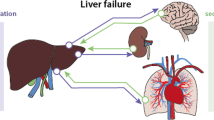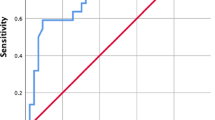Abstract
Objective
In critical illness, liver dysfunction (LD) is associated with a poor outcome independently of other organ dysfunctions. Since strategies to support liver function are not available, a timely and accurate identification of factors promoting LD may lead to prevention or attenuation of its consequences. The aim of this study was to assess risk factors for LD in critically ill patients.
Design
Prospective, observational study.
Setting
A multidisciplinary intensive care unit (ICU) of a university hospital.
Patients
All patients consecutively admitted over a 6-month period.
Intervention
None.
Measurements and results
LD was defined as serum bilirubin levels ≥ 2 mg/dl and lasting for at least 48 h. Out of 283 patients, 141 matched inclusion criteria. Forty-four patients (31.2%) showed LD (LD group), while 97 (68.8%) were included in control group (C group). A binomial analysis showed that LD occurrence was associated with moderate (odds ratio [OR] 3.11; p = 0.04) and severe shock (OR 3.46; p = 0.05), sepsis (OR 3.03; p = 0.04), PEEP ventilation (OR 4.25; p = 0.006), major surgery (OR 4.03; p = 0.03), and gram-negative infections (OR 3.94; p = 0.002). In stepwise multivariate analysis, the single independent predictive factors of LD resulted in severe shock (p = 0.002), sepsis (p = 0.03), PEEP ventilation (p = 0.04), and major surgery (p = 0.05).
Conclusions
In critically ill patients jaundice is common, and severe shock states, sepsis, mechanical ventilation with PEEP and major surgery are critical risk factors for its onset. Since there is no specific treatment, prompt resuscitation, treatment of sepsis and meticulous supportive care will likely reduce its incidence and severity.


Similar content being viewed by others
References
Strassburg CP (2003) Shock liver. Best Pract Res Clin Gastroenterol 17(3):369–381
Hawker F (1991) Liver dysfunction in critical illness. Anaesth Intensive Care 19:165–181
Vincent JL, Moreno R, Takala J, Willatts S, De Mendonca A, Bruining H, Reinhart CK, Suter PM, Thijs LG (1996) The SOFA (Sepsis-related Organ Failure Assessment) score to describe organ dysfunction/failure. On behalf of the Working Group of Sepsis-Related Problems of the European Society of Intensive Care Medicine. Intensive Care Med 22(7):707–710
Helftenbein A, Windolf J, Sanger P, Hanisch E (1997) Incidence and prognosis of postoperative jaundice in surgical intensive care patients. Chirurg 68(12):1292–1296
Harbrecht BG, Doyle HR, Clancy KD, Townsend RN, Billiar TR, Peitzman AB (2001) The impact of liver dysfunction on outcome in patients with multiple injuries. Am Surg 67(2):122–126
Esteban A, Anzueto A, Frutos F, Alia I, Brochard L, Stewart TE, Benito S, Epstein SK, Apezteguia C, Nightingale P, Arroliga AC, Tobin MJ, Mechanical Ventilation International Study Group (2002) Characteristics and outcomes in adult patients receiving mechanical ventilation. A 28-day International Study. JAMA 287:345–355
Franson TR, Hierholzer Jr MJ, LaBrecque DR (1985) Frequency and characteristics of hyperbilirubinemia associated with bacteremia. Rev Infect Dis 7:1–9
Harbrecht BG, Zenati MS, Doyle HR, McMichael J, Townsend RN, Clancy KD, Peitzman AB (2002) Hepatic dysfunction increases length of stay and risk of death after injury. J Trauma 53:517–523
Gimson AES (1987) Hepatic dysfunction during bacterial sepsis. Intensive Care Med 13:162–166
Johnson EE, Hedley-Whyte J, Hall SV (1977) End-expiratory pressure ventilation and sulfobromophthalein sodium excretion in dogs. J Appl Physiol 43:714–720
Träger K, Radermacher P, Georgieff M (1996) PEEP and hepatic metabolic performance in septic shock. Intensive Care Med 22:1274–1275
Chung C, Buchman AL (2002) Postoperative jaundice and total parenteral nutrition-associated hepatic dysfunction. Clin Liver Dis 6:1067–1084
American College of Chest Physicians/Society of Critical Care Medicine Consensus Conference (1992) Definitions for sepsis and organ failure and guidelines for innovative therapies in sepsis. Crit Care Med 20:864–874
Katz MH (2003) Multivariable analysis: a primer for readers of medical research. Ann Intern Med 138:644–650
Malbrain M, Chiumello D, Pelosi P, Wilmer A, Brienza N, Malcangi V, Bihari D, Innes R, Cohen J, Singer P, Japiassu A, Kurtop E, De Keulenaer B, Daelemans R, Del Turco M, Cosimini P, Ranieri M, Jacquet L, Laterre P, Gattinoni L (2004) Prevalence of intra-abdominal hypertension in critically ill patients. A multicenter epidemiological study. Intensive Care Med 30(5):822–829
Maynard ND, Bihary DJ, Dalton N, Beale R, Smithies MN, Mason RC (1997) Liver function and splanchnic ischemia in critically ill patients. Chest 111:180–187
Brinkman A, Calzia E, Träger K, Radermacher P (1998) Monitoring the hepato-splanchnic region in the critically ill patient. Measurement techniques and clinical relevance. Intensive Care Med 24:542–556
Marshall JC, Cook DJ, Christou NV, Bernard GR, Spring CL, Sibbald WJ (1995) Multiple organ dysfunction score: a reliable descriptor of a complex clinical outcome. Crit Care Med 23:1638–1652
Le Gall JR, Klar J, Lemeshow S, Saulnier F, Alberti C, Artigas A, Teres D (1996) The logistic organ dysfunction system. A new way to assess organ dysfunction in the intensive care unit. JAMA 276:802–810
Te Boekhorst T, Urlus M, Doesburg W, Yap SH, Goris RJ (1988) Etiologic factors of jaundice in severely ill patients. A retrospective study in patients admitted to an intensive care unit with severe trauma or with septic intra-abdominal complications following surgery and without evidence of bile duct obstruction. J Hepatol 7(1):111–117
Kaihara S, Rutherford RB, Schwentker EP, Wagner HN (1969) Distribution of cardiac output in experimental hemorrhagic shock in dogs. J Appl Physiol 27:218–222
Ayuse T, Brienza N, O'Donnell CP, Robotham JL (1994) Pressure-flow analysis of portal vein and hepatic artery interactions in porcine liver. Am J Physiol 267:H1233–H1242
Jakob SM, Tenhunen JJ, Laitinen S, Heino A, Alhava E, Takala J (2001) Effects of systemic arterial hypoperfusion on splanchnic hemodynamic and arterial buffer response in pigs. Am J Physiol Gastrointest Liver Physiol 280:G819–827
Richardson PDI, Withrington PG (1981) Liver blood flow II. Effects of drugs and hormones on liver blood flow. Gastroenterology 81:356–375
Yang S, Zhou M, Chaudry IH, Wang P (2001) Norepinephrine-induced hepatocellular dysfunction in early sepsis is mediated by activation of alpha-2-adrenoceptors. Am J Physiol Gastrointest Liver Physiol 281:G1014–G1021
Dhainaut JF, Marin N, Mignon A, Vinsonneau C (2001) Hepatic response to sepsis: interaction between coagulation and inflammatory processes. Crit Care Med 29:S42–S47
Ayuse T, Brienza N, Revelly JP, O'Donnell CP, Boitnott JK, Robotham JL (1995) Alterations in liver hemodynamic in an intact porcine model of endotoxin shock. Am J Physiol H1106–H1114
Gilroy RK, Mailliard ME, Gollan JL (2003) Cholestasis of sepsis. Best Pract Res Clin Gastroenterol 17(3):357–367
Pirovino M, Meister F, Rubli E, Karlaganis G (1989) Preserved cytosolic and synthetic liver function in jaundice of severe extrahepatic infection. Gastroenterology 96(6):1589–1595
Hedley-Whyte J (1976) Effect of pattern of ventilation on hepatic, renal, and splanchnic function. In: Hedley-Whyte J (ed) Applied physiology of respiratory care. Little, Brown, Boston, pp 27–36
Brienza N, Revelly JP, Ayuse T, Robotham JL (1995) Effects of PEEP on liver arterial and venous blood flows. Am J Respir Crit Care Med 152:504–510
Winsö O, Biber B, Gustavsson B, Holm C, Milsom I, Nieman D (1986) Portal blood flow in man during graded positive end-expiratory pressure ventilation. Intensive Care Med 12:80–85
Brienza N, Ayuse T, O'Donnell CP, Permutt S, Robotham JL (1995) Regional control of venous return: Liver blood flow. Am J Resp Crit Care Med 155:511–518
Bredenberg CE, Paskanik AM (1983) Relationship of portal hemodynamic to cardiac output during mechanical ventilation with PEEP. Arch Surg 198:218–222
Kiefer P, Nunes S, Kosonen P, Takala J (2000) Effect of positive end-expiratory pressure on splanchnic perfusion in acute lung injury. Intensive Care Med 26:376–383
Rabe C, Schmitz V, Paashaus M, Musch A, Zickermann H, Dumoulin FL, Sauerbruch T, Caselmann WH (2004) Does intubation really equal death in cirrhotic patients? Factors influencing outcome in patients with liver cirrhosis requiring mechanical ventilation. Intensive Care Med 30:1564–1571
Author information
Authors and Affiliations
Corresponding author
Rights and permissions
About this article
Cite this article
Brienza, N., Dalfino, L., Cinnella, G. et al. Jaundice in critical illness: promoting factors of a concealed reality. Intensive Care Med 32, 267–274 (2006). https://doi.org/10.1007/s00134-005-0023-3
Received:
Accepted:
Published:
Issue Date:
DOI: https://doi.org/10.1007/s00134-005-0023-3




